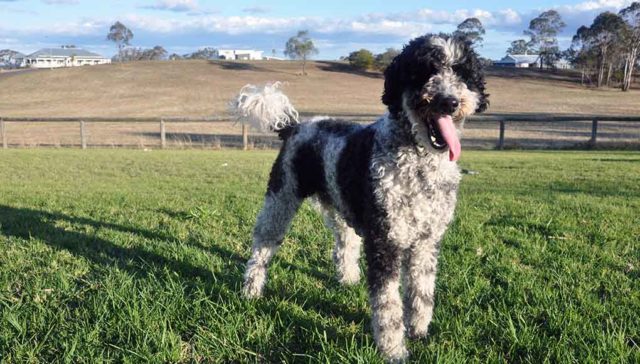
Table of Contents
Quite a curvy Schnauzer? That’s a Schnoodle!
In this article, we're going to talk about the Schnoodle dog breed. Schnoodle is a cross between a Schnauzer and a Poodle.
They are smart, active, and beautiful dogs that can be a great addition to your family. They look quite soft and delicate, but these dogs are actually quite active.
Schnoodles are one of the best family and companion dogs. Their friendly and lively temperament will keep owners and families entertained with their company.
Schnoodle puppies are quite fascinating as they are also quite observant. They analyze the people and animals they surround themselves with and their very vocal regarding their feelings.
Schnoodles are quite honest when they’re uncomfortable and in distaste. If you want a dog that is pretty transparent and easy to understand, you may want this mixed-breed dog for your own!
Let’s take a further look at what Schnoodle is like!

Schnoodle History
Schnoodles are still quite relatively new. Since Poodles have different sizes from their toy to standard, there are also quite a lot of Schnoodle varieties.
Schnoodles were made around the 1980s when Poodle mixes became prominent. The breed was made to create a Poodle mix wherein the trait to shed less is emphasized. Sadly not all Poodles and Schnauzers have been tested before breeding.
This has caused a lot of Schnoodles to inherit congenital diseases from their parent breeds. That is why breeders are encouraged to test screen their dogs before breeding to lessen the risk and low-quality of future litters.
Schnoodle Physical Traits
Schnoodles sizes may still vary since it may depend on the Poodle breed it came from. Poodles come from toy to standard.
Standard Schnoodles may stand from 10-26 inches weighing from 5 to 70 pounds.
The Schnoodle mixed breed has medium to long coats. Their coat usually varies from wavy to curly. They rarely shed but their hair grows quite quickly.
Schnoodles coat comes in a variety of colors from black, brown, cream, fawn, grey, red, white, and yellow. They may have patterns from bicolor, sable, then black and tan.
Schnoodles inherit their boxy facial features from their Schnauzer breed. Their head shape is round but their muzzles are box-like in shape. It’s long and ends edgy as well.
The Schnoodle crossbreed has round dark eyes. They do not protrude nor deep.
Their ears are medium in length quite half of their face often. Their ears flop down towards their face as well.
Schnoodles have a very fit body figure as well. It looks quite muscly at a distance and their shape is quite parallel from front to back. Although their hindlegs are quite higher than their forelegs.
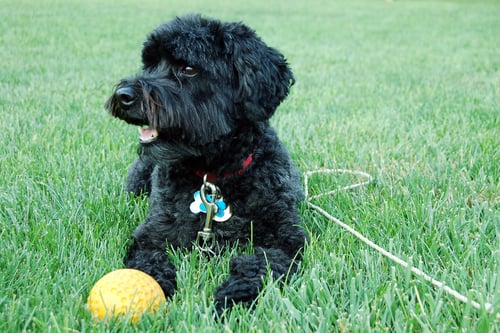
Temperament of a Schnoodle
Schnoodles are awesome dogs, to begin with. Their personality and build are quite perfect for lap dogs and companion dogs or just about anything with a family.
Schnoodles make a great family dog. They’re active enough and also enjoy spending time with their family with any activity.
From walks, fetching, watching the tv, or just sleeping, Schnoodles enjoy their owner’s company quite really well.
Schnoodles may need supervision around children since they’re very keen on who they want to be around them. They are very observant and are quite zealous regarding their feelings.
Schnoodles need some time to be comfortable around new people. They would first assess if that new person is a threat to them or a friend.
After some time of being around them, the Schnoodle dog breed will eventually open up to strangers if they don’t feel any danger or discomfort.
Schnoodles may become timid and anxious. Thus, they need a lot of careful social interaction.
Living with a Schnoodle
Schnoodles do well with other dogs and animals but they do need a substantial amount of socialization from their younger stage until they’re older. This can help them socialize and recognize safety and confidence.
The Schnoodle mixed breed is very much adaptive to their owners' or families' living settlements and lifestyles. They can live in apartments or houses with or without backyards.
Schnoodles will do well as long as their essentials are provided, especially proper diet, training, and exercise.
Schnoodles do not require large space requirements, as long as they have ample space to be around you and roam around their home. Schnoodle tolerates warm weather but may need some cover-up during colder ones.
The Schnoodle dog breed can be left alone for a short amount of time. As long as they are worn out from playtime or have an activity they can leisure while the owners are out for a bit, they’ll be able to manage.
Schnoodles should not be left alone for more than four hours or more. They also have velcro dog tendencies and may develop separation anxiety and depression.
At times, they may become destructive and stubborn if idle or bored. So, it's best to ask a dog sitter to look after your Schnoodle when you're gone.
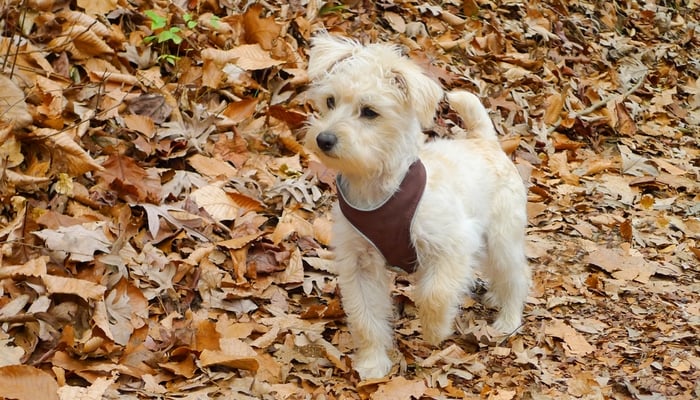
Training & Exercise for Schnoodles
Schnoodles are known to be active during their young age. Owners should use this opportunity to train their Schnoodles.
Schnoodles are quite intelligent and would like to be active. Owners can introduce training activities that involve obedience, problem-solving and basic commands.
Schnoodles need entertainment in terms of training and exercises as they may become bored easily and stubborn. Positive reinforcement and praise are best with Schnoodles during training.
Early socialization is a must for Schnoodles so they can recognize and establish relationships well with other animals, places, and people.
Exercise for Schnoodles may depend as well but this crossbreed does not require extensive physical activities. A brisk walk in the park or a run around in the backyard for at least 30 minutes to an hour daily is enough.
Exercises and training should be spilled throughout the day so Schnoodles wouldn’t get bored.
Schnoodle Health Care
Schnoodles are quite a healthy breed. Schnoodles can live from 10 to 15 or more years even.
Sadly some Schnoodles may still inherit some of the diseases from their pure parents. Here are the following conditions that they may inherit and owners should look out for:
Addison’s Disease
Addison's Disease is a deficiency in the hormonal balance that causes the dog to have recurring gastrointestinal issues, unstable due to lack of an outlet for stress, and gradual loss of body state.
Although it cannot be prevented, having your dog checked up as recommended and keeping their medications taken up to date may decrease painful effects.
Diabetes Mellitus
Diabetes Mellitus is a chronic endocrine disease caused by insulin deficiency. This is often diagnosed in middle-aged or older felines and canines.
Treatment may depend on the case. Doctors may often recommend maintenance medication and diet restrictions to manage diabetes in dogs.
Dilated Cardiomyopathy
Dilated Cardiomyopathy is a gradual escalating loss of function and heart abnormalities. Due to heart muscles dilating and thinning of walls, heart failure is possible.
Dogs with this condition often have fluid build-up in the lungs can cause difficulty in breathing. Over time, the fluid buildup may become fatal for the dog.
Schnoodles should get their electrocardiography regularly, especially when they’re an adult, to detect whether they have an ongoing condition.
There is no prevention of heart diseases in dogs yet. But, with regular and follow-up checkups, a healthy lifestyle, and a diet, chances may decrease.
Epilepsy
The causes of idiopathic seizures are unknown, but it is an inherited cognition. Some Schnoodle crossbreeds may suffer from this condition and there is no known cure as of now.
Veterinarians may administer anti-seizure but it can only decrease the severity of the seizure. Make sure to have your Schnoodle checked immediately to provide the right medication for the condition.
Eye Problems (Cataracts, Progressive Retinal Atrophy)
A cataract is an obstruction of lens fiber in the lens of an eye. Although this is more common in elderly dogs, it can also be acquired through genetics, traumatic injuries in the eyes, nutritional deficiencies, or diabetes.
Have your pet get an ophthalmic examination to detect small cataracts as early as they step four to five years old.
To determine whether it is blinding or not, it is better to check with your veterinarian to be informed what procedure should be done.
Progressive Retinal Atrophy is a degenerative disease that affects the rod and cone cells in the eyes that leading to blindness.
It is an inherited disease and it’s known for it has no treatment. It can also progress quickly from a year or two.
This test can help determine if the Schnoodle is carrying this gene. This can help discontinue the defective gene, by avoiding breeding the dog. Still, it’s best to know the dog’s condition before breeding.
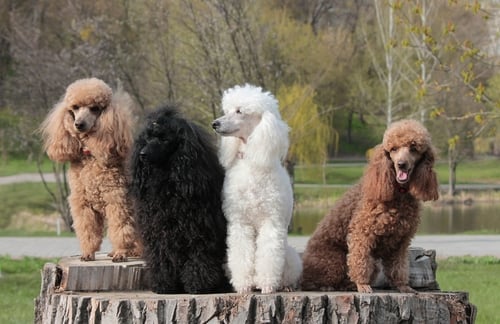
Gastric Torsion
Gastric Torsion or bloating in dogs is a gastrointestinal condition where-in a dog’s stomach expands due to it teeming with fluid, food, or gas.
This can be a fatal circumstance if left untreated. In some cases due to bloating, blood is trapped in the stomach preventing return and proper flow.
Prevention includes avoiding your dog to do activities right after a meal, eating meals too fast, large meals throughout the day, and stressing them. Treatment may depend on your veterinarian's observation.
Legg-Calve-Perthes Disease
Also known as Aseptic Necrosis of the femoral head, Legg-Calve-Perthes Disease is the loss of blood supply in the ball at the of the femur which causes it to break down inside the hip joint. This is an incredibly painful disease and may need surgery for treatment.
Sadly, it is an inherited disease and can be spotted while they are just months old. Limping and visible distress can be pronounced symptoms.
It is best to have your Schnoodle checked and regularly tested for this disease. Prevention and reducing risk are the responsibility of owners.
Pancreatitis
Pancreatitis is the inflammation of the pancreas. This is often found in Schnauzers so Schnoodles should look out for it.
Pancreatitis left unaddressed can be severe or fatal. Schnoodles should be immediately checked if the owners suspect any symptoms.
Patellar Luxation
Patella Luxation is the patella shifting alignment out of the femur. This can range from high to low levels of luxation, and each requires different treatments.
Symptoms may include skipping and kicking off the leg. It’s best to consult with the Veterinarian for treatments, therapies, or procedures required to help Schnoodle with this condition.
Remember not to breed Havanese dogs who have these diseases. It’s best not to bring these despairing conditions to other dogs.
Diet of a Schnoodle
Schnoodles vary in size depending on the Poodle breed since Poodles have different sizes as well. This mixed dog breed will require a high-quality diet.
It can be dry or wet food or even mixed. Schnoodles must be fed at least twice to thrice a day and have their meals split unto two or three.
Remember not to overfeed Schnoodles as obesity may affect their health. Since some Schnoodles are prone to joint problems, the extra weight may strain their joints.
Treats should be given only when necessary and in little amounts. If Schnoodles have big appetites, owners should control or at least reciprocate ample exercise to balance them.
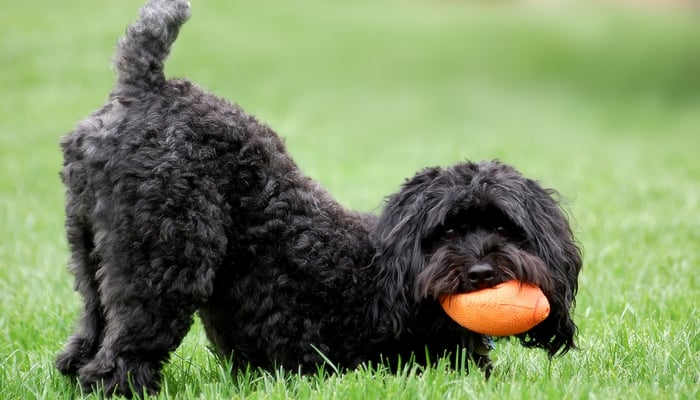
Schnoodle Grooming and Care
Schnoodles have an extensive level of grooming. But, it may heavily depend on the coat they have inherited from the parent breed. Fortunately, both breeds have a low level of shedding.
Coat
Schnoodles may require frequent visits to the groom to have their coat cut. Since Schnoodles often have wavy to curly fur, managing it when its length is too long may be difficult.
Curly and wavy hair is prone to tangles as well, it also may be prone to grime and dirt sticking to it.
Schnoodles may visit the groomer at least once a month for their haircut. Schnoodles should be bath at least once a week.
They should also bathe after activities that get them dirty. Grime build-up may be difficult to remove with just brushing.
Schnoodles will require a lot of brushing even if they are slightly shed. Since their hair is curly-wavy, tangles may often form. Tangles can be painful when left untouched.
Brushing can also help keep their coat healthy as it promotes natural oil to come out, brushing is enough to distribute it.
Ears
Schnoodles’ ears are quite full of fur outside and inside their ear flaps.
Their ears also flop down their face, so it would be difficult to let them dry on their own. It’s important to have their ears pat dried after each bath or swim.
Schnoodles are prone to ear infections and moisturized ears are one of the reasons a dog can acquire ear infections. So make sure to have their ears pat dry at least.
Nails
Schnoodles' nails should be trimmed or filed at least once every two weeks. Nail trimming should be undemanding.
This behavior can be easily influenced by any dog as long as they are exposed to these things calmly and casually.
Remember during their grooming regimen, have them in their relaxed state while you also keep your calm. Dogs can sense our emotions and mirror them.
It’s best to hold or caress their paw from time to time so they don’t deem the activity as something unusual. As time passes by and they get used to the feeling, nail trimming will be easy-peasy.
Teeth
This goes the same for brushing their teeth. It doesn’t need to be a daily activity but doing it at least twice a week is enough.
Brushing their teeth from a young age can help them recognize the activity as a routine. Plus, it can help them familiarize the feeling without being fearful of it.

Frequently Asked Questions about Schnoodles
How large does a Schnoodle get?
Since Schnoodle sizes will vary depending on their parent breed, it also varies but Schnoodles with Toy Poodle breed mix will grow at least 9-11 inches in height.
Miniature Poodles may be 12-15 inches in height and standard Poodles may stand 15-18 inches in height.
Do Schnoodles bark a lot?
Schnoodles are known to be very vocal. They are quite expressive and they use barking as a medium.
Owners or families should consider this before adopting a Schnoodle to avoid problems they may encounter in their homes.
Early socialization and basic training can lessen their barking but it may require some effort.
Are Schnoodles high maintenance?
Schnoodles can be quite high maintenance, especially in the grooming aspects. Since their coat grows quite quickly and it's a curly and wavy texture, it’s important to groom it frequently.
Schnoodles also require a lot of socialization and basic training of obedience while they’re still young since they are quite quick to catch on and may get stubborn.
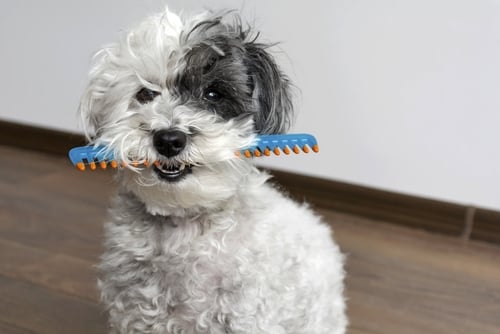
Schnoodle Dog Breed Summary
Schnoodles are the best teddy bears in the family. They can be someone you can cuddle with while sleeping or watching tv or just spend time with their owners no matter what they’re doing.
Schnoodles are an amazing breed one should look out for! Their boxy faces and soft stature are quite irresistible too!
If you are interested in adopting a Schnoodle puppy, please do consider adopting from a responsible and reputable breeder rather than buying in puppy mills.
This can help dogs from having low-quality lives and lesser life expectancy due to the health issues they may inherit.
Have your Schnoodle regularly checked and vaccinations updated all the time! It’s important to look out for them as they do with you!












